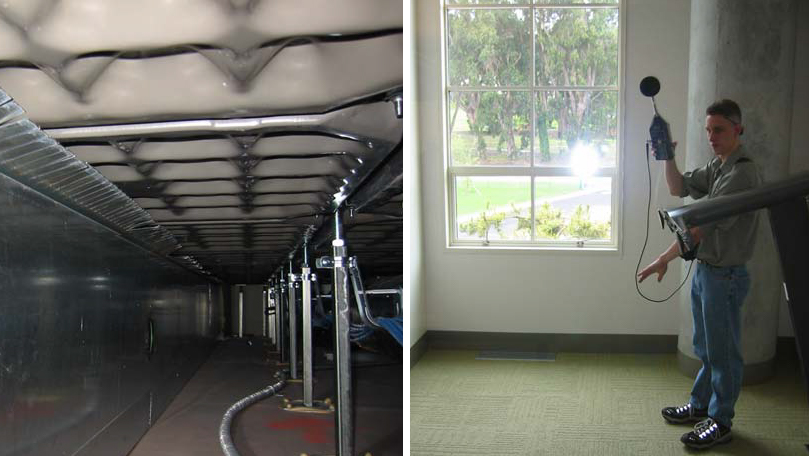Verifying acoustical performance of as-built partitions and acoustical construction.
Status: Completed
Funding Sources: CBE Industry Consortium
Project Objective
Conduct a field study to quantify the sound transfer in an office environment in a building with an underfloor air distribution (UFAD) system, where acoustical performance is an important consideration.
Significance to Industry
Architects, mechanical engineers, and facility planners are interested in UFAD systems because of energy conservation, flexibility and other potential benefits. These systems include multiple openings in a raised floor, and may include a variety of non-standard wall types. Consequently design professionals, building owners and tenants have expressed concerns about potential sound transfer between adjacent spaces, and the possibility of unacceptable speech privacy.
Studies have shown that noise is probably the most prevalent source of annoyance in offices, and noise can lead to increased stress levels for occupants. Speech privacy may be an even more important design consideration than noise. Yet, acoustics, in most cases, does not receive the level of design attention as thermal, ventilation, lighting, and other architectural and engineering considerations.
Research Approach
For this project CBE is collaborating with Charles M. Salter Associates, consultants in acoustics, audio-visual system design, and telecommunications. The research team is utilizing a new office building with known wall types and acoustical detailing. Prior to final occupancy of the building, the researchers conducted 17 acoustical tests between adjoining spaces. The office spaces in the building have differing acoustical requirements, which fall into five broad categories.
The acoustical testing methodology follows the U.S. General Services Administration’s Workplace 20•20 testing protocol for private offices, “Field measurement of sound insulation in buildings.” The measurements were normalized to account for the furnished conditions. The source sound level, received sound level and background noise were tape recorded. The tape recordings were played back in our laboratory to measure the 1/3 octave band required as part of the testing protocol.
This study represents acoustical measurements in a building with an underfloor ventilation system designed to meet the needs of a particular client. Other plenum layout conditions, floor constructions, partition choices, room sizes and design considerations may yield different results. Future phases of this research may include additional field or laboratory studies to answer more generic questions with respect to the acoustical performance of UFAD systems.
Publications and Reports
Salter, C. and R. Waldeck, 2006. Designing Acoustically Successful Work Places: A Case Study Assessment of the Speech Privacy and Sound Isolation of Spaces Having Underfloor Air Distribution Systems. CBE Summary Report, April.

